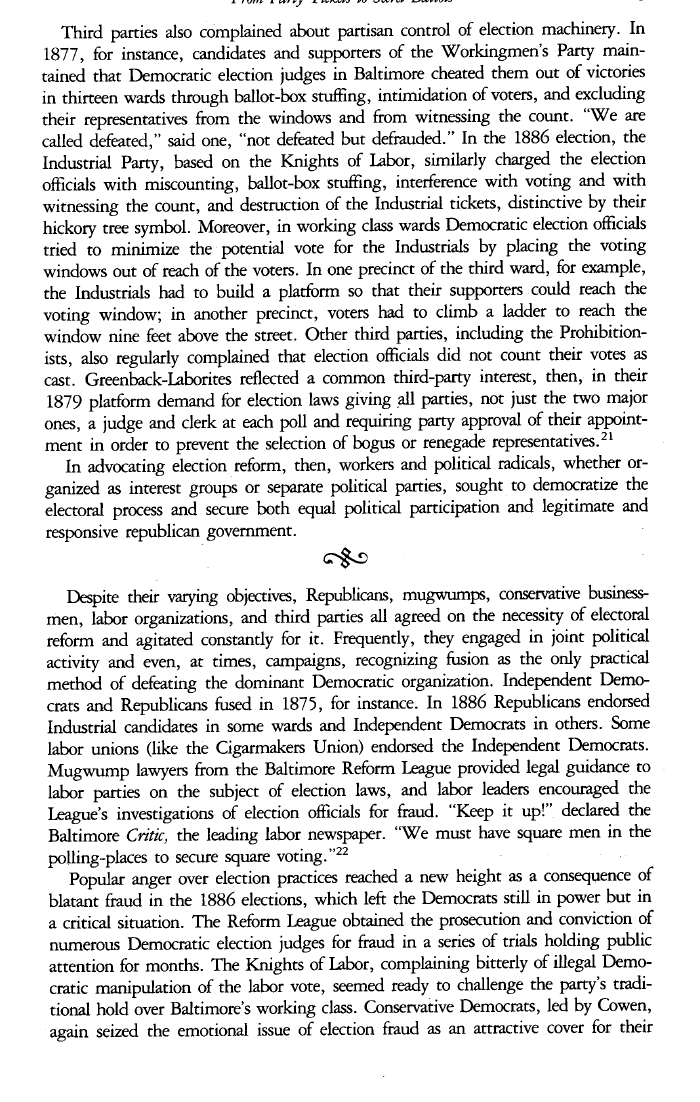|
Third parties also complained about partisan control of election machinery.
In
1877, for instance, candidates and supporters of the Workingmen's Party
main-
tained that Democratic election judges in Baltimore cheated them out of
victories
in thirteen wards through ballot-box stuffing, intimidation of voters, and
excluding
their representatives from the windows and from witnessing the count. "We
are
called defeated," said one, "not defeated but defrauded." In the 1886
election, the
Industrial Parry, based on the Knights of Labor, similarly charged the
election
officials with miscounting, ballot-box stuffing, interference with voting
and with
witnessing the count, and destruction of the Industrial tickets,
distinctive by their
hickory tree symbol. Moreover, in working class wards Democratic election
officials
tried to minimize the potential vote for the Industrials by placing the
voting
windows out of reach of the voters. In one precinct of the third ward, for
example,
the Industrials had to build a platform so that their supporters could
reach the
voting window; in another precinct, voters had to climb a ladder to reach
the
window nine feet above the street. Other third parties, including the
Prohibition-
ists, also regularly complained that election officials did not count their
votes as
cast. Greenback-Laborites reflected a common third-party interest, then, in
their
1879 platform demand for election laws giving all parties, not just the two
major
ones, a judge and clerk at each poll and requiring party approval of their
appoint-
ment in order to prevent the selection of bogus or renegade
representatives. Z'
In advocating election reform, then, workers and political radicals,
whether or-
ganized as interest groups or separate political parties, sought to
democratize the
electoral process and secure both equal political participation and
legitimate and
responsive republican government.
Despite their varying objectives, Republicans, mugwumps, conservative
business-
men, labor organizations, and third parties all agreed on the necessity of
electoral
reform and agitated constantly for it. Frequently, they engaged in joint
political
activity and even, at times, campaigns, recognizing fusion as the only
practical
method of defeating the dominant Democratic organization. Independent Demo-
crats and Republicans fused in 1875, for instance. In 1886 Republicans
endorsed
Industrial candidates in some wards and Independent Democrats in others.
Some
labor unions (like the Cigarmakers Union) endorsed the Independent
Democrats.
Mugwump lawyers from the Baltimore Reform League provided legal guidance to
labor parties on the subject of election laws, and labor leaders encouraged
the
League's investigations of election officials for fraud. "Keep it up!"
declared the
Baltimore Critic, the leading labor newspaper. "We must have square men in
the
polling-places to secure square voting." 22
Popular anger over election practices reached a new height as a consequence
of
blatant fraud in the 1886 elections, which left the Democrats still in
power but in
a critical situation. The Reform League obtained the prosecution and
conviction of
numerous Democratic election judges for fraud in a series of trials holding
public
attention for months. The Knights of Labor, complaining bitterly of illegal
Demo-
cratic manipulation of the labor vote, seemed ready to challenge the
parity's tradi-
tional hold over Baltimore's working class. Conservative Democrats, led by
Cowen,
again seized the emotional issue of election fraud as an attractive cover
for their
|

